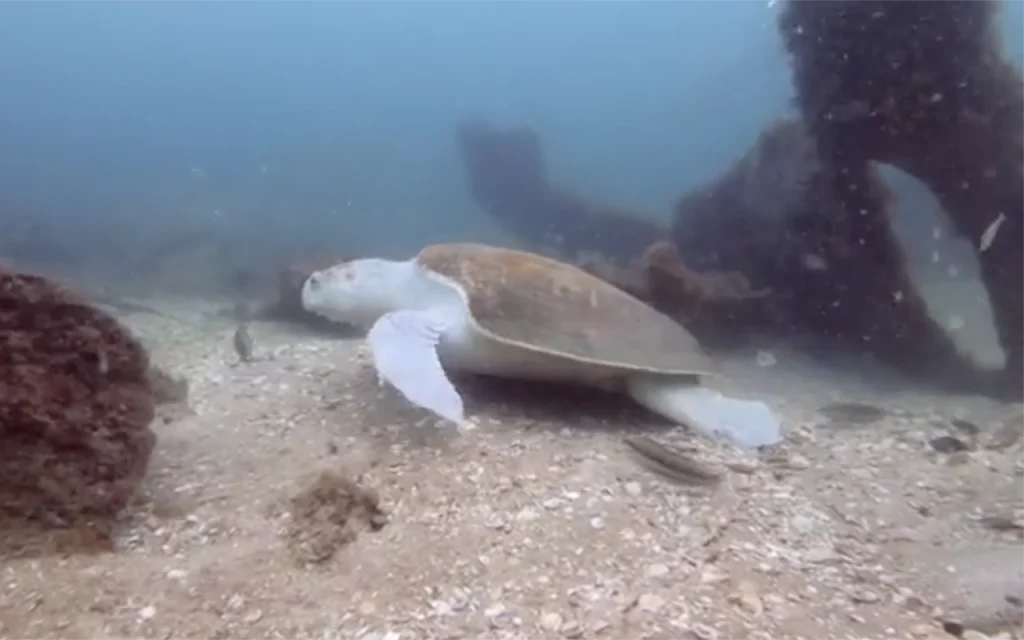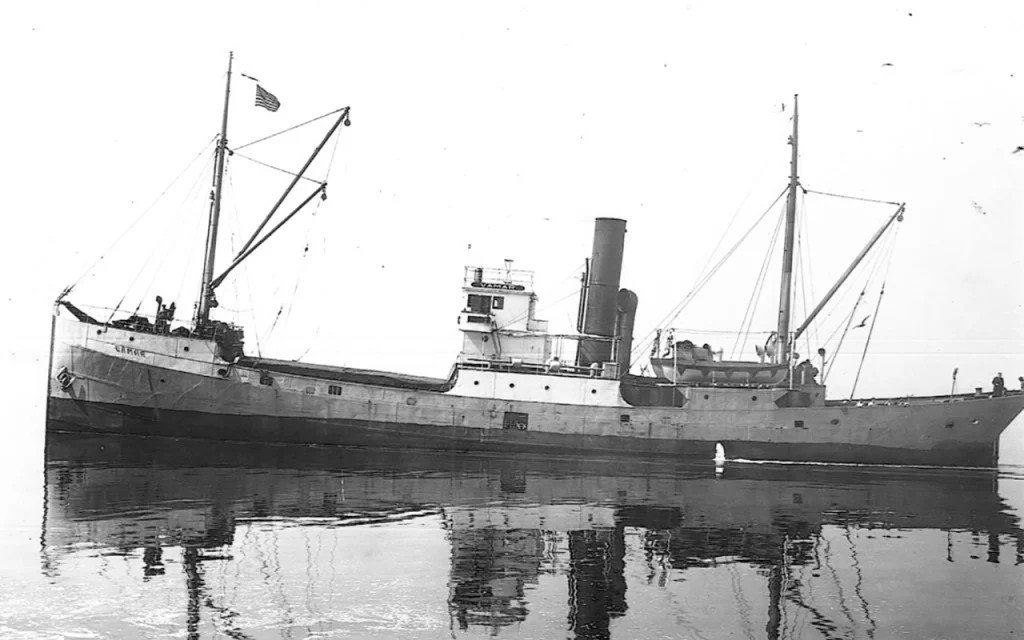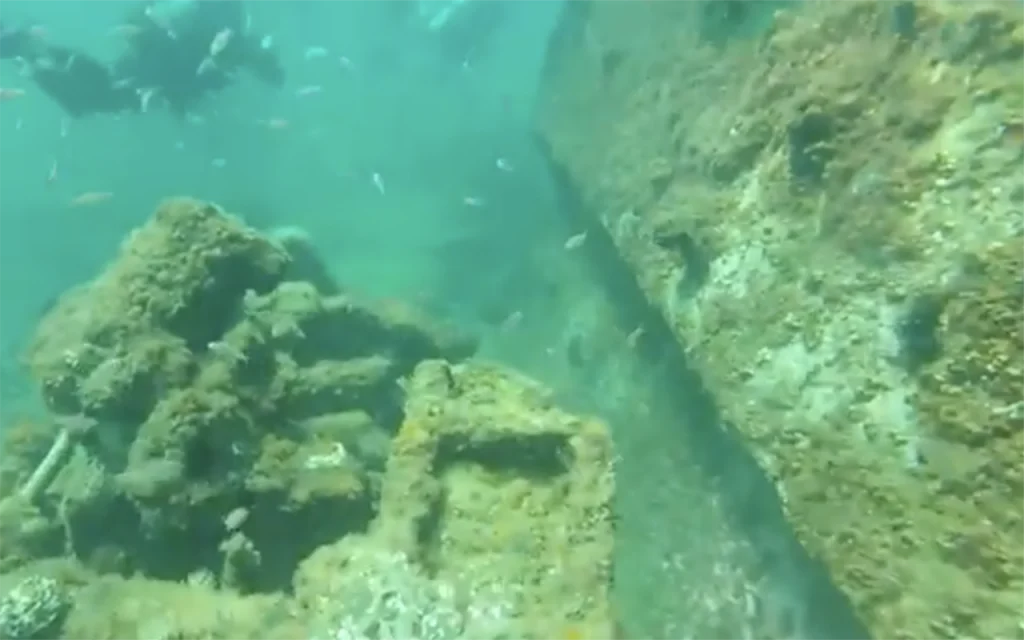Table of Contents

The combination of structural complexity from the wreck and the variety of marine life makes the Vamar a vibrant underwater ecosystem, attracting both divers and marine enthusiasts alike.
Article at a Glance
- Historical Significance: The Vamar, originally built as a patrol gunboat in 1919, served in Admiral Richard E. Byrd’s Antarctic expedition before sinking in 1942 while overloaded with lumber.
- Wreck Location: The wreck is located at approximately 29° 53.941′ N latitude and 85° 27.806′ W longitude, lying in about 25 feet of water off the coast of Mexico Beach, Florida.
- Unique Features: Divers can explore various historical features, including the hull plates, deck beams, a large steam engine, bilge keels, and a capstan, which provide insight into the ship’s construction and operation.
- Marine Life: The wreck has become an artificial reef, attracting diverse marine species such as snapper, grouper, amberjack, and southern stingrays, enhancing the underwater experience for divers.
- Safety Measures: Safety protocols include the use of a diver-down flag, adherence to safe diving practices, and the option for guided dives with experienced operators to ensure a safe and enjoyable experience.
- Dive Shops: Several dive shops, including Scuba Panama City Beach and local Carrabelle dive shops, offer guided trips to the Vamar, providing equipment rentals and expert guidance.
- Preservation Status: The Vamar is designated as an Underwater Archaeological Preserve, ensuring its protection and historical significance for future generations of divers and marine enthusiasts.
Vamar Wreck Location Coordinates and Depth
Depth
The wreck lies in approximately 25 feet of water, making it accessible for divers. The Vamar sank on March 21, 1942, while carrying lumber from Port St. Joe, Florida.
Location Coordinates
The wreck of the Vamar is located at the following coordinates:
- Latitude: 29° 53.941′ N
- Longitude: 85° 27.806′ W
What to Scuba Divers Say About This Wreck
Accessibility and Depth
- The Vamar is located in 25 feet of water, making it an accessible dive site for both novice and experienced divers. The relatively shallow depth allows for easy exploration, though conditions can vary with tides and weather.
Wreck Features
- The wreckage provides a rich structure for divers to explore, including hull plates, deck beams, chains, and a capstan. These features create an interesting underwater landscape that attracts marine life and enhances the diving experience.
Historical Significance
- Divers appreciate the historical context of the Vamar, which was originally built as a patrol gunboat and later became famous for its role in Admiral Byrd’s Antarctic expedition. This history adds a layer of intrigue to the dive, as many divers enjoy learning about the vessel’s past while exploring the wreck.
Marine Life
- The wreck serves as an artificial reef, attracting various marine species. Divers often report sightings of fish and other sea creatures, making the dive not only a historical exploration but also a vibrant ecological experience.
Overall Experience
- Many divers describe the Vamar as a great shallow water dive, suitable for those looking for an easy yet rewarding underwater adventure. The combination of history, structure, and marine life contributes to its reputation as a popular dive site in the Florida area.
What Kind of Marine Life Can Be Found on The Wreck
Marine Life Found on the Vamar Wreck
- Coral Growth: The wreck has become a habitat for various types of coral, which contribute to the underwater ecosystem.
- Fish Species:
- Snapper: Commonly seen around the wreck, these fish are known for their vibrant colors and are a favorite among divers.
- Grouper: Often spotted resting in the structure of the wreck, groupers are large, robust fish that add to the biodiversity of the area.
- Amberjack: These fast swimmers are also found in the vicinity of the wreck.
- Spanish Mackerel: Known for their speed and agility, they are frequently observed by divers.
- Other Marine Animals:
- Southern Stingrays: These graceful creatures can often be seen gliding along the sandy bottom near the wreck.
- Toadfish: Known for their unique appearance and behavior, toadfish can be found hiding in crevices of the wreck.
- Larger Residents: Divers often encounter larger species such as Goliath Grouperand Nurse Sharks, which are known to roam around the wreck, adding an element of excitement to the dive experience.
Key Information
| Key Information | Details |
|---|---|
| Wreck Name | Vamar |
| Location | Off the coast of Port St. Joe, Florida |
| Coordinates | 29° 53.941′ N, 85° 27.806′ W |
| Depth | Approximately 25 feet |
| Historical Significance | Originally a patrol gunboat, served in Byrd’s Antarctic expedition, sank in 1942 |
| Marine Life | Snapper, grouper, amberjack, southern stingrays, and more |
| Dive Shops | Various local dive shops offer guided dives to the wreck |
| Safety Measures | Diver-down flag required, safe diving practices encouraged |
| Preservation Status | Designated as an Underwater Archaeological Preserve |
What Makes Vamar a Unique Diving Experience
Historical Significance
- Rich History: Originally built as a patrol gunboat in England, the Vamar gained fame for its role in Admiral Richard E. Byrd’s Antarctic expedition in 1928. It was instrumental in delivering supplies, including the first aerial flyover of the South Pole, before becoming a tramp freighter and ultimately sinking under mysterious circumstances in 1942 while carrying lumber to Cuba.
Accessibility
- Shallow Depth: The wreck lies in approximately 25 feet of water, making it accessible to divers of all skill levels. This shallow depth allows for easy exploration and is ideal for novice divers, while still providing enough intrigue for experienced divers.
Underwater Features
- Diverse Structure: Divers can explore a variety of wreck features, including a large steam engine, bilge keels, and other remnants of the ship. The structural complexity of the wreck provides an engaging environment for underwater exploration.
Marine Life
- Ecological Habitat: The Vamar has become an artificial reef, attracting a diverse range of marine life. Divers often encounter various fish species, corals, and other marine animals, enhancing the overall diving experience.
Conservation and Preservation
- Underwater Archaeological Preserve: The site is recognized as an underwater archaeological preserve, which helps protect its historical and ecological significance. This designation ensures that the wreck remains a point of interest for future generations of divers and historians alike.
Scenic Location
- Scenic Dive Spot: Located near Port St. Joe, Florida, the Vamar wreck is situated in a picturesque area that offers additional recreational opportunities, making it a great destination for divers and their families.
What is The Full History of This Wreck
Construction and Early Years
- Built in 1919: The Vamar was originally constructed as a patrol gunboat for the British Royal Navy, named HMS Kilmarnock. It was part of the Kil class of vessels and was built by Smiths Dock Company in Middleboro, England.
- Name Changes: Over the years, the ship underwent several name changes:
- 1920-1923: Renamed S.S. Kilmarnock.
- 1926: Registered in Canada as S.S. Kilmarnock.
- 1928: Sold to a private firm and renamed Chelsea.
- 1928-1930: Acquired by Rear-Admiral Richard Byrd for his Antarctic expedition and renamed Eleanor Bolling in honor of his mother. During this expedition, the ship was nicknamed “Evermore Rolling” due to rough seas.
Transition to Commercial Use
- Seal Hunting and Further Sales: After its Antarctic service, the ship was sold to a seal hunting company in 1930 and later purchased by the Vamar Shipping Company in 1933, which renamed it Vamar.
- Final Ownership: In 1941, the vessel was sold to Bolivar-Atlantic Navigation Company and registered under the Panamanian flag, continuing its use as a tramp freighter.
Sinking of the Vamar
- Incident Leading to Sinking: On March 19, 1942, the Vamar entered Port St. Joe, Florida, to take on a load of lumber destined for Cuba. On March 21, while leaving the port, the ship was reported to be overloaded and top-heavy. As it navigated the channel, it began to list and subsequently capsized in approximately 25 feet of water off Mexico Beach, Florida.
- Suspicion and Investigation: The sinking raised suspicions of sabotage, particularly given the wartime context. A Coast Guard investigation followed, but despite local beliefs that the ship had been intentionally sunk to block the channel, no evidence substantiated these claims. The pilot reported that the ship’s condition and overloading were likely causes of the sinking.
Preservation and Recognition
- Underwater Archaeological Preserve: In 2002, the Vamar was nominated to become Florida’s ninth Underwater Archaeological Preserve, recognizing its historical and ecological significance. It was officially dedicated in 2004.
- National Register of Historic Places: On April 10, 2006, the Vamar was added to the U.S. National Register of Historic Places, ensuring its preservation for future generations.

What Historical Features Can Still Be Identified on Wreck
Structural Remains
- Hull Plates: Large sections of the iron hull are still intact, providing insight into the ship’s construction and design. The hull plates are a significant feature for understanding the vessel’s integrity and the materials used in its construction.
- Deck Beams: Divers can observe the remnants of the deck beams, which are crucial for maintaining the structural integrity of the ship. These beams give an indication of the ship’s original layout and design.
- Bilge Keels: The wreck features exposed bilge keels, which were designed to enhance stability and prevent rolling in rough seas. This aspect of the wreck provides valuable information about the ship’s engineering.
Machinery and Equipment
- Steam Engine: A prominent feature of the wreck is the large steam engine, which is partially exposed. This engine is significant for understanding the technology of the time and the ship’s operational capabilities.
- Capstan and Rudder: The wreck includes a capstan, used for handling heavy lines and cables, and a rudder, which are essential components that illustrate the ship’s functionality and navigation.
- Generator: The remains of the generator that powered the ship are also visible, showcasing the technological advancements of the era.
Artifacts and Environment
- Marine Life: The wreck has become an artificial reef, attracting diverse marine life, including corals, snapper, grouper, amberjack, and other species. This ecological aspect enhances the diving experience and illustrates the wreck’s role in supporting marine biodiversity.
- Cement Monument: A cement monument with a bronze plaque designates the site as an Underwater Archaeological Preserve, marking its historical significance and ensuring its protection for future generations.
Archaeological Significance
The Vamar wreck site is recognized for its potential to yield new information about early 20th-century maritime technology and the modifications made for polar exploration. Its designation as an Underwater Archaeological Preserve highlights its importance for public education and historical preservation.

What Safety Measures Are in Place for Divers Visiting Vamar
Safety Measures for Divers
- Diver-Down Flag: Divers are required to display a “diver-down” flag while submerged. This signals to boaters and other water users that divers are in the vicinity, helping to prevent accidents and ensure visibility.
- Safe Diving Procedures: Divers are encouraged to follow safe diving practices, including proper buoyancy control, monitoring air supply, and adhering to dive tables or computers to avoid decompression sickness.
- Depth Awareness: The wreck lies in approximately 25 feet of water, which is relatively shallow. Divers should still be aware of their depth and the conditions, as they can change with tides and weather.
- Site Protection: The Vamar wreck is protected by Florida laws that forbid unauthorized disturbance, excavation, or removal of artifacts. This legal protection helps maintain the site’s integrity and ensures a safe environment for divers.
- Guided Dives: Many divers choose to participate in guided dives led by experienced dive operators familiar with the site. These guides can provide valuable information about the wreck and ensure that safety protocols are followed.
- Environmental Awareness: Divers are advised to be mindful of the marine environment, avoiding contact with the wreck and marine life to prevent damage to both the site and the ecosystem.
Dive Shops That Prove Diving Trips to This Shipwreck
- Scuba Panama City Beach
This dive shop provides guided dives to the Vamar wreck, emphasizing its historical significance and marine life. They offer various diving packages suitable for different skill levels. More information can be found on their website: Scuba Panama City Beach . - Carrabelle Area Dive Shops
Several dive shops in the Carrabelle area organize trips to the Vamar wreck as part of their offerings. These shops typically provide equipment rentals and guided dives, making it easier for divers to explore the site. You can find more details about diving in the area at Carrabelle.org .





